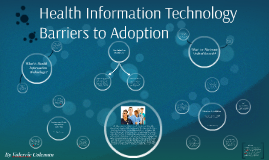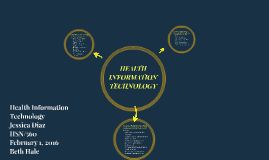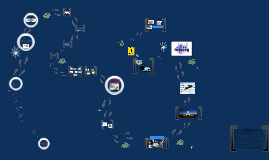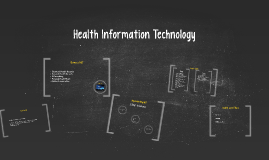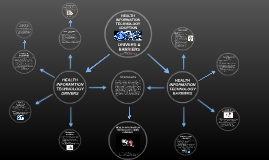Health Information Technology
Transcript: Health information technology American Recovery and Reinvestment Act (ARRA) Enacted in 2009 “Stimulus” law Designed to spark the economy Federal Health Information Technology for Economic and Clinical Health act of 2009 (HITECH). Medical professionals use HIT to communicate and store information for later use. HIT and electronic health (e-health) can change the future healthcare workforce. Studies on the use of HIT Assistance provided by the use of HIT Improvement in efficiency of care Emerging Trends in HIT Health care exchanges Transmission of health care data State, regional, community or hospital system Formal or informal Unique patient identifier Correctly connecting /matching patient with EHR Interoperability Captures data from disparate sources and pulls it together Impact of HIT on Healthcare and Nursing Practice Informatics principles for nursing To create a vision for the future of nursing that bridges the quality chasm with information technology, enabling nurses to use informatics in practice and education to provide safer, higher-quality patient care. Computer Science Valuable tool Acquisition of Data Supports EBP Cognitive Science Nursing science Information science Computer science Informatics + Nursing Effective and safe care Reduction of medical errors Improve problem-solving Quality of care Confidentiality, Security, and HIPAA Confidentiality of HIT need for access blocking access privacy vs confidentiality HIPAA Security Hardware and software issues and maintenance Tracking access and changes Data input Method of access Passwords ID badges Biometric data HIPAA implications Act of 1996 Protected Health information Employee training Challenges as a result of HIT National Health Network Long-term meaningful usefulnes Interooperability References Audet, A., Squires, D., & Doty, M.M. (2014). Where are we on the diffusion curve? Trends and drives of primary care physicians’ use on health information technology. .Health Services Research, 49(1), 347-360. Cipriano, P.F., Bowles, K., Dailey, M., Dykes, P., Lamb, G., & Naylor, M., (2013). The importance of health information technology in care coordination and transitional care. Nursing Outlook, 61, 475-489. Dowding, D. (2015). Using health information technology to support evidence-based Practice. Worldviews on Evidenced-Based Nursing, 12(3), 129-130. Gabriel, M.H., Jones, E.B., Samy, L. & King.J. (2014). Progress and challenges: implementation and use of health information technology among critical-access hospitals. Health Affairs, 33(7), 1262-1269. Graham-Jones, P., Jain, S.H., Friedman, C.P., Marcotte, L., & Blumenthal, D. (2012). The need to incorporate health information technology into physicians; education and professional development. Health Affairs 31(3), 481-487. Healthcare Information and Management Systems Society (himss). (http:// www.himss.org/content/files/HIMSS2009InformaticsNurseImpactSurvey.pdf) Leung, R.C. (2011). Health information technology and dynamic capabilities. Health Care Management, 37(1), 43-53. McCartney, P. R., & Drake, E. E. (2016). Perinatal and neonatal health information technology. Journal of Perinatal and Neonatal Nursing, 30, 209-213. doi: 10.1097/JPN.0000000000000184 McGonigle, D. & Mastrian, K.G. (2015). Nursing informatics and the foundation of knowledge. Burlington: Jones & Bartlett Learning. O’Malley, A.S. (2011). Tapping the unmet potential of health information technology. New England Journal of Medicine, 364(12), 1090-1091. Selck, F.W. & Decker, S.L. (2016). Health information technology adoption in the emergency department. Health Services Research, 51(1), 32-47. Thede, L. (2012). Informatics: Where is it? The Online Journal of Issues in Nursing, 17 (1). doi: 10.3912/OJIN.Vol17No1InfoCol01 Wasen, K. (2013). Emerging Health Technology. New York: Springer. Wiener, J. A., & Gilliland, A. T. (2011). Balancing between two goods: Health insurance portability and accountability act and ethical compliancy considerations for privacy-sensitive materials in health sciences archival and historical special collections. Journal of the Medical Library Association, 99, 15-22. doi: 10.3163/1536-5050.99.1.005 Weiner, J.P., Yeh, S., & Blumenthal, D. (2013). The impact of health information technology and e-health on the future demand for physician services. Health Affairs, 32(11), 1998- 2004. Avoid Disruption Security Breach Downtime Policies What is Health Information Technology (HIT) Key Purpose Health Information Technology Medical record improvement Ease in record maintainability Documentation improvement Improved readability Widely adopted in developed countries. Remote Delivery Healthcare Health care professional have remote access to patients. This change was possible secondary to healthcare information technology advancement. Patients living in remote areas have acesss to quality health care at a reasonable cost. Impact of HIT Connie Eadie, Jewell Parker, Renece Waller-Wise Impact of HIT Electronic Health






